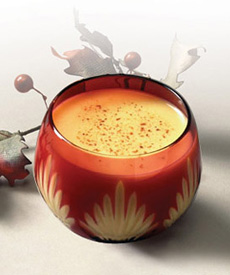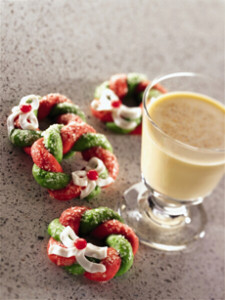Eggnog History: Know Your Eggnog!
|
Eggnog or egg nog is a descendant of milk-and-wine punches that had long been part of European celebrations when colonists arrived in the Americas. Rum, a New World distillation, enabled a spirited substitution for the wine. And eggnog history? Eggnog became a popular wintertime drink throughout Colonial America. Then as now, people loved the rich, spicy, alcoholic brew. President George Washington was quite a fan of eggnog. His own recipe, which included rye whiskey, rum, and sherry, was reputed to be so stiff a drink that only the most courageous could down it. Brandy joined rum in the basic recipe much later—as part of a book promotion! In the 1820s, Pierce Egan wrote a novel called “Life of London: or Days and Nights of Jerry Hawthorne, Esq. and His Elegant Friend Corinthian Tom.” You can pick up a copy on Amazon. Just as today’s mixologists and publicists know how to generate buzz with a new cocktail, Egan created a variation of eggnog he called the “Tom and Jerry.” The half ounce of brandy he added to the basic recipe furthered egg nog’s popularity—and fortunately, the original name prevailed. Here’s more about the Tom and Jerry. December 24th is National Eggnog Day. The research site InDepthInfo.com notes that “Egg nog, in the 1800s, was nearly always made in large quantities and nearly always used as a social drink. “It was commonly served at holiday parties and it was noted by an English visitor in 1866, [that] ‘Christmas is not properly observed unless you brew egg nogg for all comers; everybody calls on everybody else; and each call is celebrated by a solemn egg-nogging…It is made cold and is drunk cold and is to be commended.’” Baltimore initiated a tradition where young men made the rounds of their friends on New Year’s Day, enjoying a bracing cup of eggnog at each home. The more homes one visited, the more “braced” one became. It was considered a feat to actually finish one’s rounds. How times change! Aside from today’s attitudes toward moderation, would anyone give up football to continue the tradition? |
 [1] Eggnog served old-school, in a fancy punch cup (photo © AllWhitesEggWhites.com).
|
|
|
As with most things in the murky past, there are different stories on the origins of eggnog. The “egg” part is easy: There are eggs in the recipe (along with sugar, rum, milk, whiskey/bourbon/rum/brandy, heavy cream, vanilla, and ground nutmeg). The two contenders for the “nog” portion: *The term grog is named after Old Grog, the nickname of Edward Vernon (1684-1757), a British admiral who ordered that diluted rum be served to his sailors. The nickname is derived from grogram, after his habit of wearing a grogram cloak—a coarse fabric made of silk, mohair, wool, or a blend of them. Isn’t etymology fascinating? |
||
 [3] A glass of eggnog served with eggnog wreath cookies (photo © Wisconsin Milk Marketing Board). |
MORE EGG NOG RECIPES: EGGNOG VARIATIONS Conventional eggnog recipes vary by the type of spirits used, or how elaborate they get, from topping with simple whipped cream to ice cream and chocolate shavings. If you don’t have a family eggnog recipe, ask your friends. Or take a look at these: |
|
|
EGGNOG FOR DESSERT For the holidays, serve one or more eggnog desserts. Start with eggnog ice cream from your grocer, and continue on to: And HAPPY NEW YEAR from THE NIBBLE. CHECK OUT WHAT’S HAPPENING ON OUR HOME PAGE, THENIBBLE.COM. |
||



